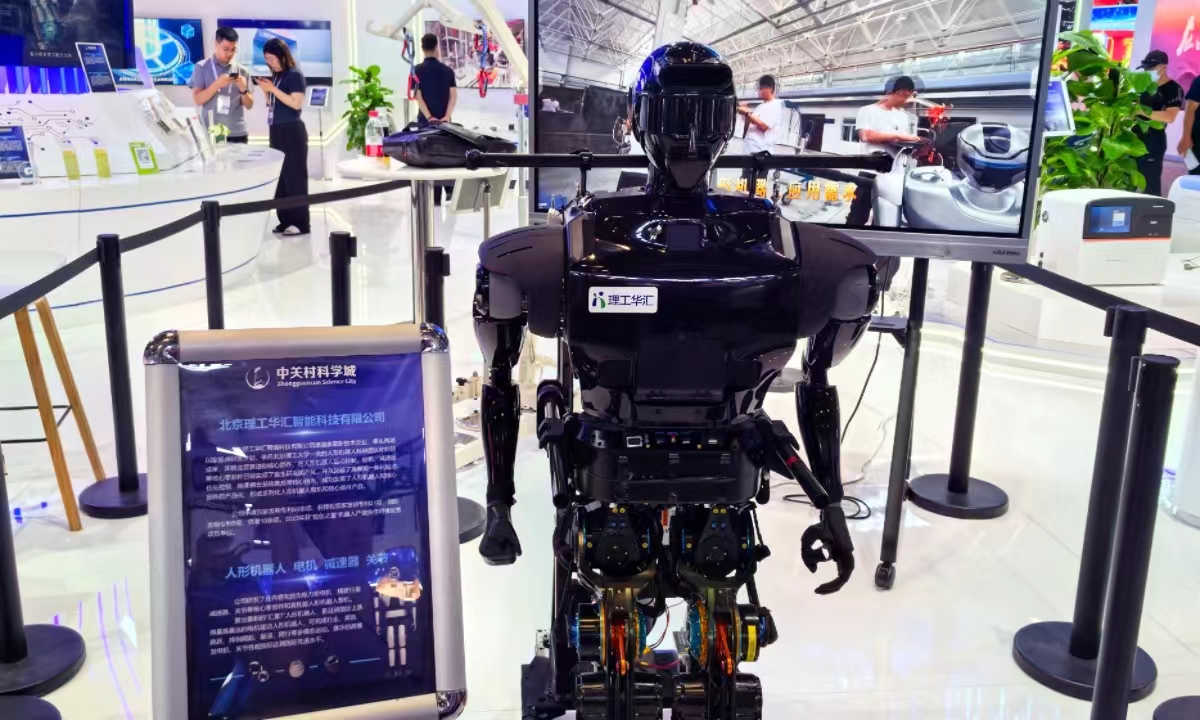Humanoid robots in spotlight at Beijing High-Tech Expo, as Chinese companies ramp up new tech innovation

"Huitong 7," by a Chinese robot manufacturer, showcased at the 2024 Beijing International High-Tech Expo. This 1.7-meter, 55-kilogram humanoid robot can walk, run, jump, fall, roll, and crawl in different complex terrains. It boasts the world's highest and farthest jumps for a motor-driven humanoid robot, reaching 0.5 meters in height and 1 meter in distance. Photo: Zhang Yiyi/GT
Jumping and running like a human, nimbly sending coffee, even chatting with people… lots of humanoid robots showcased their skills and interacted with visitors during 2024 Beijing International High-Tech Expo being held from July 13 to 16 in Beijing.
"Huitong 7," which resembles a human form with a height of 1.7 meters and a weight of 55 kilograms, can perform various multi-modal movements, like walking, running, jumping, falling, rolling, and crawling. It can jump up to 0.5 meters in height and 1 meter in distance, making it the highest and farthest jumping motor-driven humanoid robot in the world.
"Ninety percent of the robot's hardware is domestically produced. We primarily aim to apply it in specialized fields such as emergency rescues and firefighting, and other dangerous circumstances," a representative from Haribit told the Global Times on Tuesday.
The employee mentioned that the robot is not commercially available on a large scale and is priced at 3 million yuan (approximately $428,571), making it suitable mainly for specific applications. "We are currently in talks with various manufacturers and institutions about possible collaborations," he said.
Another robot, resembling a doll, also attracted considerable attention. Named the Intelligent Companion Robot, it was developed by a team of Chinese university students and has a 95-percent domestic production rate. The lamp-sized device is ideally suited for desk placement.
"This type of communication robot is on sale abroad, such as in the US. However, our model stands out due to its human-like expressions, movements, and tones, which facilitate more natural interactions. It is the first robot in the world with a long-term memory function for family use, capable of recording human speech and expressions, with users having the option to select what it remembers," Wang Chenghao, a product director from TechVoyage, told the Global Times on Tuesday.
"We plan to launch the product on Chinese e-commerce platforms in 2025, at a competitive price of around 5,000 yuan," said Wang.
In recent years, an increasing number of Chinese enterprises, large or small, have jumped onto the bandwagon to develop humanoid robots, with an expanding variety of robot models showcased to suit specific scenarios. The diversification owes much to breakthroughs in proprietary technologies by domestic companies, encompassing both software and hardware.
However, the transitioning from development to mass commercialization of humanoid robots in China, expected to take five to six years, means lots of challenges to be overcome, experts said.
Currently, commercial humanoid robots are mainly employed in industrial sectors like metallurgy - say steel manufacturing, which often use large-scale models to create specialized robots to perform high-risk tasks. Additionally, communicative humanoid robots are easier to market due to simpler production and more affordable pricing, Liu Gang, chief economist at the Chinese Institute of New Generation AI Development Strategies, told the Global Times on Friday.
"In contrast, commercializing service-use humanoid robots remains a challenging job. Their intelligence levels are significantly lower than the human brain, with the top models only achieving 0.2 percent of human capacity, making it hard to interact with human naturally. Also, the high cost of the robots makes it unaffordable for most consumers," Liu said.
"Some of our components, such as joints and software, rely on imports. We are slightly behind the developed countries in embodied intelligence. However, significant investment is boosting humanoid robot development in China. Once domestic production of the components gains pace, more Chinese enterprises will engage in research and development, Liu said.
The scale of China's humanoid robot industry is expected to reach 20 billion yuan by 2026, according to a recent report by state broadcaster CCTV. Humanoid robotics is a future industry that requires integration across multiple industries, and Chinese companies have high enthusiasm to ramp up research and development, industry observers said.
